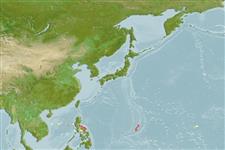Teleostei (teleosts) >
Callionymiformes (Dragonets) >
Callionymidae (Dragonets)
Etymology: Synchiropus: Greek, syn, symphysis = grown together + Greek, cheir = hand + Greek, pous = foot (Ref. 45335).
More on author: Fricke.
Environment: milieu / climate zone / depth range / distribution range
Ecology
Marine; reef-associated; depth range 2 - 35 m (Ref. 90102). Tropical; 16°N - 13°N
Western Pacific: Malaysia, Indonesia, the Philippines, Papua New Guinea. Guam, Northern Marianas and the Chesterfield Islands.
Size / Weight / Age
Maturity: Lm ? range ? - ? cm
Max length : 2.3 cm SL male/unsexed; (Ref. 28618)
Found on seaward reefs of Guam and Tinian, to a depth of 8 m (Ref. 1602). Inhabits sand-rubble bottoms 2-35 m deep (Ref. 90102).
Life cycle and mating behavior
Maturity | Reproduction | Spawning | Eggs | Fecundity | Larvae
Fricke, R., 2016. Synchiropus novaehiberniensis, a new species of dragonet from New Ireland, Papua New Guinea, western Pacific Ocean, with a review of subgenus Synchiropus (Neosynchiropus) and description of a new subgenus (Teleostei: Callionymidae). J. Nat. Hist. (Ref. 111072)
IUCN Red List Status (Ref. 130435: Version 2024-1)
Threat to humans
Harmless
Human uses
Tools
Special reports
Download XML
Internet sources
Estimates based on models
Preferred temperature (Ref.
123201): 28.4 - 28.8, mean 28.6 °C (based on 26 cells).
Phylogenetic diversity index (Ref.
82804): PD
50 = 0.5000 [Uniqueness, from 0.5 = low to 2.0 = high].
Bayesian length-weight: a=0.00955 (0.00394 - 0.02313), b=2.96 (2.75 - 3.17), in cm total length, based on LWR estimates for this (Sub)family-body shape (Ref.
93245).
Trophic level (Ref.
69278): 3.1 ±0.3 se; based on size and trophs of closest relatives
Resilience (Ref.
120179): High, minimum population doubling time less than 15 months (Preliminary K or Fecundity.).
Fishing Vulnerability (Ref.
59153): Low vulnerability (10 of 100).
